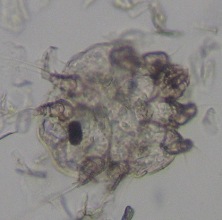Mites in Guinea Pigs
Does your guinea pig have dry scaley skin? Does it scratch itself constantly and make noises like it just can't get comfortable? Does it sometimes fall on its side and seem to be twitching like a seizure? Chances are your guinea pig is suffering from skin mites or some other skin parasites (ectoparasites).

One mite, known as Trixicarus caviae, may be difficult to detect. Your veterinarian may suggest skin scrapes, “tape preps”, or even biopsies of the skin to help diagnose your guinea pig. Skin scrapes look for parasites, such as Trixicara, that burrow beneath the skin. Tape preps look for parasites that spend part of their time on the surface of the skin. When mites or other ectoparasites are found, that strongly supports that the skin parasites are causing the guinea pig’s problems. Failure to find anything on the skin scrape and tape test does not completely rule out ectoparasites -- Trixicara mites may not be found unless over a dozen skin scrapings are performed! Clearly this amount of skin scraping is not in the best interest of the guinea pig so it may be better to try “response to treatment” if a guinea pig’s initial skin scrape is negative. Biopsies may sometimes find parasites that are missed by the skin scrapes or may detect another underlying illness.
 Dander, flakes, and fur loss due to Trixicarus caviae infestation.
Dander, flakes, and fur loss due to Trixicarus caviae infestation.
It is important to allow a veterinarian to perform the tape preps and skin scrapes since there are other ectoparasites besides Trixicara. Many of the other ectoparasites are easy to detect and may be quite easy to treat. On the other hand, Trixicara can be quite resistant to treatment and may take several months of medication to eliminate. Some guinea pigs may never fully eliminate the mite and require a monthly treatment with selamectin or ivermectin to stay healthy. Extra vitamin C daily is essential to help the skin return to health.
 Healing after treatment for mites. It may take weeks for the fur to fully regrow.
Healing after treatment for mites. It may take weeks for the fur to fully regrow.



